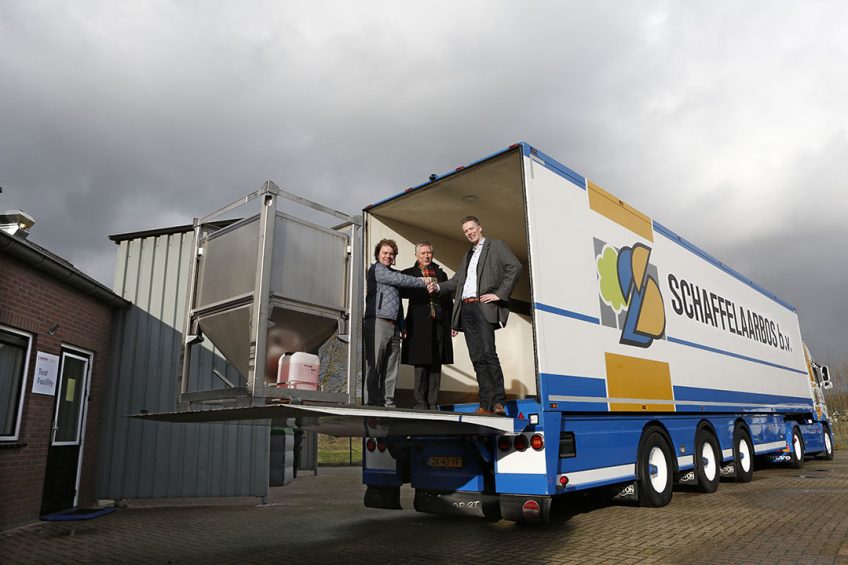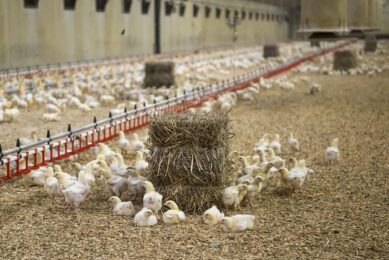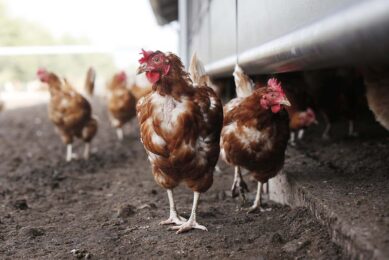SELEGGT stops day-old-chick culling

Killing day-old male chicks will soon be history. German and French ministers of Agriculture have announced the 31 December 2021 as the end date. The Netherlands will soon be following.
The company SELEGGT carries out in-ovo sex determination, resulting in no males being born and killed in their hatchery in Barneveld, the Netherlands. Companies Schaffelaarbos and SELEGGT started a unique co-operation. Male eggs that have been sorted out, are processed “just-around-the-corner” at Schaffelaarbos. On 28 January 2020 Mr De Kruijf, Councilor of Barneveld, witnessed the first delivery of the full tanks of male eggs of 2020.
Sex determination to prevent male chick culling
Layer type day old male chicks are usually sorted out and killed at the first day of their lives. The ethical and animal welfare aspects of culling male chicks form an increasing issue for the egg industry. SELEGGT has a hatchery in which no males are killed. Martijn Haarman, managing director of SELEGGT explains: “After 9 days of incubation a laser creates a tiny hole in the hatching egg. A little droplet of fluid will come out through this hole. The droplet is checked for presence of female hormones. If no female hormones are present, it means that the egg holds a future male and our robot sorts it out. Only those hatching eggs in which a female develops, are going back into the incubator.”
A part of the traditionally culled layer males are used in zoo’s or for feeding birds of prey. Now that we stop culling males, it is very important that there is a good circular application for the male eggs that are sorted out.” – Martijn Haarman, SELEGGT.
After sorting the male eggs immediately flow into a tank. Tanks full of fluid male eggs including egg shells are stored in a cold store and periodically collected. The same system is applied by Schaffelaarbos at regular hatcheries for collecting infertile eggs. After 21 days of incubation the chicks, females only, are born and brought to a rearing house. When the chicks have grown up, they will produce eggs that can be sold with the respeggt-label ‘free of chick culling’. In Germany and France such eggs have been available for a while now. Dutch retailer Jumbo will be the first in Holland to start selling respeggt-eggs in March 2020.
Also read: France to ban culling of male chicks
Hatching eggs regulations
Eggs that have been incubated for 9 days are a new product. Therefore these eggs were not explicitly defined in the animal by-products regulations. Martijn Haarman explains: “A part of the traditionally culled layer males are used in zoo’s or for feeding birds of prey. Now that we stop culling males, it is very important that there is a good circular application for the male eggs that are sorted out.”
SELEGGT and Schaffelaarbos started a cooperation. In Germany permission to process male eggs into feed component was easily obtained. Dutch authority NVWA studied the case carefully and also reached the conclusion that eggs after 9 days of incubation are a CAT3 by-product, meaning they are safe and officially allowed for feed applications.
Processing into powder and Steggcal
When the tanks with male eggs arrive at Schaffelaarbos, which is only a few kilometres away from the hatchery, tanks are unloaded and tested. “Feed safety is extremely important,” tells Mathieu Woltring, managing director of Schaffelaarbos. “That is why all materials entering our plant are being tested in a laboratory.” In a next step shell is separated from the egg fluids. These product flows are treated separately. The egg fluid is dried in a spray-dryer which preserves the valuable nutrient components. The end product is a nice, egg-coloured powder with a very good shelve life. The product is delivered in powder, pellet or crumb form to feedmills, calf milk and petfood producers. The egg shells are dried and ground to grit or powder. These products, which are an easy digestible source of calcium are being sold as Steggcal in many animal feed products. Woltring concludes: “Creating sustainable ingredients for animal feed, that is our core competence.”
Join 31,000+ subscribers
Subscribe to our newsletter to stay updated about all the need-to-know content in the poultry sector, three times a week. Beheer
Beheer








 WP Admin
WP Admin  Bewerk bericht
Bewerk bericht